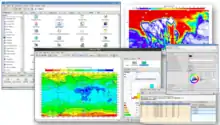Metview
Metview is a meteorological workstation and batch system developed at the European Centre for Medium-Range Weather Forecasts.[1]
 Logo of Metview | |
| Developer(s) | ECMWF |
|---|---|
| Initial release | 1991 |
| Stable release | 5.10.1
/ 9 November 2020 |
| Written in | C++, C, Python and Qt |
| Operating system | Linux, OS X |
| Available in | British English |
| Type | Scientific visualization |
| License | Apache License |
| Website | software |
History
Developments were started at ECMWF in 1990 in co-operation with the National Institute for Space Research of Brazil and Météo-France.[2]
| Year | Version | Changes |
|---|---|---|
| 1990 | Announcement | Announcement at EGOWS[3] |
| 1991 | First prototype | Batch system at National Institute for Space Research |
| 1993 | 1.0 | First batch and user interface |
| 1998 | 2.0 | Use of OpenGL for interactive visualisation |
| 2000 | 3.0 | New user interface (Motif) |
| 2010 | 4.0 | Upgrade to Magics++ graphics library;[4] released as Open-source software under Apache License[5] |
| 2014 | 4.5 | New user interface based on Qt version 4 |
| 2018 | 5.0 | Switch to Qt version 5, improved plot window and new Python interface |
Features
User interface

Metview has an icon based user interface, where any aspect of a meteorological (graphical) product is expressed in an icon. Users can prototype visualisation by dragging and dropping icons in the plot area.
Metview offers also various tools to explore and display the content of meteorological file formats, such as GRIB, BUFR, NetCDF and ODB.
Metview Macro language for batch processing
The Macro language is designed to be high level to allow analysts and scientist to concentrate on the work/processing flow they try to achieve.
# Metview Macro
# reading GRIB files through the read() function
a = read(mygrib1.grb)
b = read(mygrib2.grb)
# calculating the differences between two fields
c = a-b
# plotting the result
plot(c)
In 2017 a Python version of the macro language was developed.[6]
Development
All major developments are made at the Development Section at ECMWF. Most of the code is in C++ and the code is versioned in git. CMake is used as build system.
Metview makes use of other software packages developed at ECMWF. In fact Metview is an extended MARS client and uses ecCodes for GRIB and BUFR handling and Magics for contouring and visualisation.
Distribution
Metview is mainly distributed as a source tarball under the Apache License version 2.0. There are plans to distribute the code on GitHub.
Binary versions of Metview are available in conda (through the conda-forge channel), in Ubuntu[9] and MacPorts.[10] RPMs for major Linux distribution are provided on the Open Build Service.[11]
References
- "Metview Official Website". ECMWF. Retrieved 2 December 2017.
- Russell, Iain (January 2014). "News item in ECMWF Newsletter 138 (Winter 2013/2014): Metview's 20th Anniversary" (PDF). ECMWF.
- Daabeck, Jens (June 1990). "Report from the EGOWS meeting" (PDF). EGOWS report. 1. Archived from the original (PDF) on 2016-03-05. Retrieved 2017-12-03.
- Siemen, Stephan (2 December 2017). "2B.2 Metview 4 & Magics++ answering new challenges of increasing volumes of data (2010 - 90annual_26iips)". ams.confex.com. Retrieved 2017-12-03.
- Siemen, Stephan. "Abstract: Metview: Helping to make best use of ECMWF's data (93rd American Meteorological Society Annual Meeting)". ams.confex.com. Retrieved 2017-12-03.
- Russell, Iain (January 2020). "Metview's Python interface opens new possibilities". ECMWF Newsletter. 162: 36–39.
- Karhila, Vesa (July 2012). "BUFR data and Metview" (PDF). ECMWF Newsletter. 132: 34–36.
- Kertesz, Sandor (January 2012). "A new framework to handle ODB in Metview 4" (PDF). ECMWF Newsletter. 130: 31–33.
- "metview package : Ubuntu". launchpad.net. Retrieved 2017-12-02.
- macports-ports: The MacPorts ports tree, MacPorts, 2017-12-01, retrieved 2017-12-02
- "Show home:SStepke / Metview - openSUSE Build Service". build.opensuse.org. Retrieved 2017-12-02.